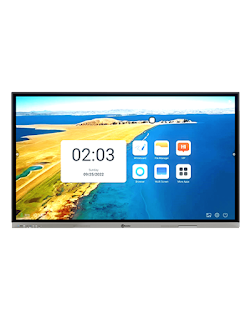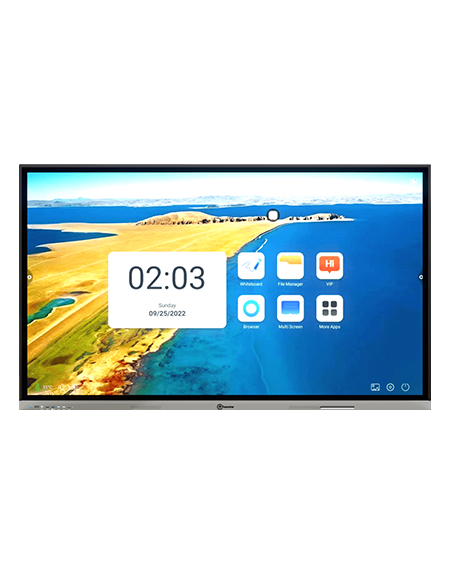Interactive Flat Panels: The Ultimate Guide
Have you ever seen a giant tablet hanging on a classroom or office wall, where people can touch and write on it? Well, that's an interactive flat panel! It may sound fancy, but it's just like a giant smartphone or tablet that can be used for learning, meetings, or presentations. In this guide, we'll explore what interactive flat panels are, how they work, and why they're so awesome.
What is an Interactive Flat Panel?
Imagine a big TV screen, but instead of just watching shows, you can touch the screen, draw, and write on it. That's what an interactive flat panel is. It's a large display that responds to your touch, making it perfect for all sorts of activities, from teaching in schools to collaborating in offices.
How Does it Work?
Inside the interactive flat panel, there are tiny sensors that detect when you touch the screen. These sensors work together with a computer that's built into the panel. When you touch the screen, the sensors send signals to the computer, telling it where you touched. This allows the panel to respond to your actions, whether it's drawing with a virtual pen or opening an app.
Why Are Interactive Flat Panels So Cool?
Engagement: Interactive flat panels make learning and meetings more engaging. Instead of just listening, you can participate by writing, drawing, or even playing educational games.
Big Screen Fun: It's like having a gigantic tablet or TV to explore. Everything is bigger and easier to see.
Save Paper: You can write or draw on the screen, so there's no need for paper or markers. It's eco-friendly!
Collaboration: In meetings or classrooms, multiple people can interact with the screen at the same time, making group work a breeze.
Endless Possibilities: Interactive flat panels can run all sorts of apps and software. From math lessons to video conferences, there's so much you can do.
No More Chalk Dust: Say goodbye to chalkboards. Interactive flat panels are much cleaner and don't create dust.
Easy to Use: They're user-friendly, even for kids. Just touch, swipe, and learn!
Interactive Learning: In schools, teachers can create interactive lessons that make learning more enjoyable.
Professional Meetings: In offices, interactive flat panels make presentations and brainstorming sessions more dynamic.
Remote Learning: They're handy for remote learning too, allowing students to connect with teachers online.
FAQs (Frequently Asked Questions):
How big are interactive flat panels?
Interactive flat panels come in various sizes, but they can be as large as 86 inches or more.
Do I need any special tools to use them?
No special tools are required. You can interact with them using your fingers or a stylus pen.
Can I connect my computer to an interactive flat panel?
Yes, you can connect your computer or laptop to an interactive flat panel to display your work or presentations.
Are interactive flat panels expensive?
They can be a bit pricey, but many schools and businesses find them worth the investment due to their versatility.
Do they work with all types of devices?
Most interactive flat panels are compatible with various devices like computers, tablets, and smartphones.
What happens if the screen gets dirty?
You can clean the screen with a soft, dry cloth or a special screen-cleaning solution to keep it looking good.
Are interactive flat panels fragile?
They are built to be sturdy, but it's still essential to handle them with care to prevent damage.
Can I use interactive flat panels for gaming?
Some interactive flat panels support gaming apps, making them fun for leisure as well.
Do they require regular maintenance?
Like any electronic device, they may need occasional maintenance, but it's usually minimal.
Can I use interactive flat panels for video conferencing?
Absolutely! Many interactive flat panels have built-in cameras and microphones for video calls.
Are they suitable for homeschooling?
Yes, they can be a great tool for homeschooling, offering interactive learning experiences.
Can I use them for art and drawing?
Yes, many interactive flat panels support drawing apps, making them ideal for art and creative projects.
How do I connect to the internet on an interactive flat panel?
Most interactive flat panels can connect to Wi-Fi, just like your smartphone or computer.
Can I download apps on them?
Yes, you can download and install educational and productivity apps on many interactive flat panels.
Do they come with warranties?
Most interactive flat panels come with warranties to cover any potential issues.
Can they be wall-mounted?
Yes, many interactive flat panels can be wall-mounted or placed on a stand.
Are they suitable for outdoor use?
They are primarily designed for indoor use and may not work correctly outdoors.
Do interactive flat panels have built-in speakers?
Yes, many models have built-in speakers for audio playback.
Can I use them for remote presentations?
Yes, interactive flat panels are excellent for remote presentations and virtual meetings.
Do they have touch-sensitive gloves for winter?
No, you can use your fingers with gloves or invest in touchscreen-compatible gloves.
Are there interactive flat panels for smaller budgets?
Yes, there are budget-friendly options available with slightly fewer features.
Can they be used for interactive quizzes in classrooms?
Yes, interactive flat panels are fantastic for creating interactive quizzes and polls.
Do they have accessibility features for people with disabilities?
Many interactive flat panels offer accessibility features, such as screen readers and magnification.
Can I connect them to a printer?
Yes, you can connect some interactive flat panels to printers to print documents and drawings.
Are there interactive flat panels for home use?
Yes, you can find smaller interactive flat panels designed for home entertainment and learning.



Comments
Post a Comment